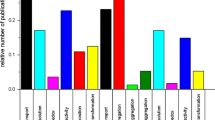Abstract
Groundwater contamination usually originates from surface contamination. Contaminants then move downward through the vadose zone and finally reach the groundwater table. To date, however, analytical solutions of multi-species reactive transport are limited to transport only in the saturated zone. The motivation of this work is to utilize analytical solutions, which were previously derived for single-phase transport, to describe the reactive transport of multiple volatile contaminants in the unsaturated zone. A mathematical model is derived for describing transport with phase partitioning of sequentially reactive species in the vadose zone with constant flow velocity. Linear reaction kinetics and linear equilibrium partitioning between vapor, liquid, and solid phases are assumed in this model.
Similar content being viewed by others
References
Baehr, A. L., Stackelberg, P. E. and Baker, R. J.: 1999, Evaluation of the atmosphere as a source of volatile organic compounds in shallow groundwater, Water Resour. Res. 35(1), 127–136.
Bear, J.: 1979, Groundwater Hydraulics, McGraw-Hill, New York.
Beljin, M. S.: 1991, Review of three-dimensional analytical models for solute transport in ground-water system, International groundwater modeling center, Holcomb Research Institute, Butler University, Indiana.
Borden, R. C. and Bedient, P. B.: 1986, Transport of dissolved hydrocarbon influenced by reaeration and oxygen limited biodegradation: Theoretical development, Water Resour. Res. 22, 1973–1982.
Bouwer, E. J., Rittmann, B. E. and McCarty, P. L.: 1981, Anaerobic degradation of halogenated 1-and 2-carbon organic compounds, Environ. Sci. Technol. 15(5), 596–599.
Cho, C. M.: 1970, Convective transport of ammonium with nitrification in soil, Can. J. Soil Sci. 51,339–350.
Clement, T. P., Sun, Y., Hooker, B. S. and Petersen, J. N.: 1998. Modeling multi-species reactive transport in groundwater aquifers, Groundwater Monitor Remedia. 18(2), 79–92.
Culver, T. B., Shoemaker, C. A. and Lion, L. W.: 1991, Impact of vapor sorption on the subsurface transport of volatile organic compounds: A numerical model and analysis, Water Resour. Res. 27(9), 2259–2270.
Freeman, D. L. and Gossett, J. M.: 1989, Biological reductive dechlorination of tetrachloroethylene and trichoroethylene to ethylene under methanogenic conditions, Appl. Eviron. Microbiol. 55(9), 2144–2151.
Glod, G., Angst, W., Holliger, C. and Schwarzenbach, R. P.: 1997, Corrinoid-mediated reduction of tetrachloroethene, trichloroethene, and trichlorofluoroethene in homogeneous aqueous solution: Kinetics and reaction mechanisms, Environ. Sci. Technol. 31, 253–260.
Golub, G. H. and Van Loan, C. F.: 1996, Matrix Computations, The John Hopkins University Press, Baltimore and London.
Hooker, B. S., Skeen, R. S. and Petersen, J. N.: 1994, Biological destruction of CCl4: kinetic modeling, Biotechnol. Bioeng. 44, 211–218.
Jury, W. A., Spencer, W. F. and Farmer, W. J.: 1983, Behavior assessment model for tracer organics in soil, I, model description, J. Environ. Qual. 12(4), 558–564.
Lunn, M., Lunn, R. J. and Mackay, R.: 1996, Determining analytic solutions of multiple species contaminant transport with sorption and decay, J. Hydrol. 180, 195–210.
McNab, W. W. Jr., Narasimhan, T. N.: 1993, A multiple species transport model with sequential decay chain interactions in heterogeneous subsurface environments, Water Resour. Res. 29(8), 2737–2746.
McCarty, P. L., Beck, L. and Amant, O. S.: 1969, Biological denitrification of wastewaters by addition of organic materials, presented at the 24th Annual Industrial Waste Conference, Purdue University, West Lafayette.
McCarty, P. L. and Semprini, L.: 1994, Ground-water treatment for chlorinated solvents. in: Norris et al.,(eds),Handbook of Bioremediation, Lewis Publishers.
Molz, F. J., Widdowson, M. A. and Benefield, L. D.: 1986, Simulation of microbial growth dynamic coupled to nutrient and oxygen transport in porous media, Water Resour. Res. 22(8), 1207–1216.
Nitao, J. J.: 1998. User's Manual for the USNT Module of the NUFT Code, Version 2 (NP-phase, NC-component, thermal), Lawrence Livermore National Laboratory, UCRL-MA-130653.
Pigford, T. H., Chambre, P. L., Albert, M., Foglia, M., Harada, M., Iwamoto, F., Kanki, T., Leung, D., Masuda, S., Muraka, S. and Ting, D.: 1980, Migration of radionuclides through sorbing media: analytical solutions II, ONWI 360(1), LBL-11616, UCB-NE-4003.
Rifai, S. H. and Bedient, P. B., 1990. Comparison of biodegradation kinetics with an instantaneous reaction model for groundwater, Water Resour. Res. 26(4), 637–645.
Shoemaker, A. C., Culver, T. B., Lion, L. W. and Peterson, M. G.: 1990, Analytical models of the impact of two-phase sorption on the subsurface transport of volatile chemicals, Water Resour. Res. 26(4), 745–758.
Sun, Y., Petersen, J. N., Clement, T. P. and Skeen, R. S.: 1999. Development of analytical solutions for multi-species transport with serial and parallel reactions, Water Resour. Res. 35(1), 185–190.
Tim, U. S. and Mostaghimi, S.: 1989. Modeling transport of a degradable chemical and its metabolites in the unsaturated zone, Ground Water 27(5), 672–681.
van Genuchten, M. Th. and Alves, W. J.: 1982, Analytical solutions of the one-dimensional convective-dispersive solute transport equation, U. S Department of Agriculture Technical Bulletin, 1661.
van Genuchten, M. Th.: 1985, Convective-dispersive transport of solutes involved in sequential first-order decay reactions, Comput. Geosci. 11(2), 129–147.
Vogel, T. M., Criddle, C. S. and McCarty, P. L.: 1987, Transformations of halogenated aliphatic compounds, Environ. Sci. Technol. 21(8), 722–736.
Waddill, D. W., Widdowson, M. A.: 1998, Three-dimensional model for subsurface transport and biodegradation, J. Environ. Eng. 124(4), 336–344.
Xu, T., Gerard, F., Pruess, K. and Brimhall, G.: 1997, Modeling non-isothermal multiphase multis-pecies reactive chemical transport in geological media, Lawrence Berkeley National Laboratory, LBNL-40504, UC-400.
Xu, T., Samper, J., Ayora, C., Manzano, M. and Custodio, E.: 1999, Modeling of non-isothermal multi-component reactive transport in field scale porous media flow systems, J. Hydrol. 214, 144–164.
Author information
Authors and Affiliations
Rights and permissions
About this article
Cite this article
Sun, Y., Petersen, J.N., Buscheck, T.A. et al. Analytical Solutions for Reactive Transport of Multiple Volatile Contaminants in the Vadose Zone. Transport in Porous Media 49, 175–190 (2002). https://doi.org/10.1023/A:1016023526537
Issue Date:
DOI: https://doi.org/10.1023/A:1016023526537




